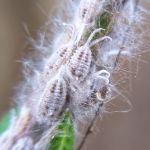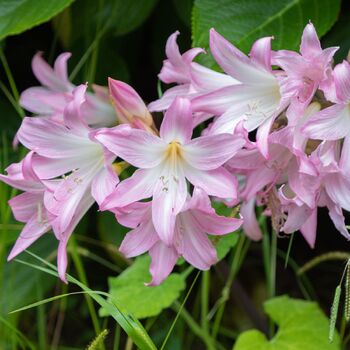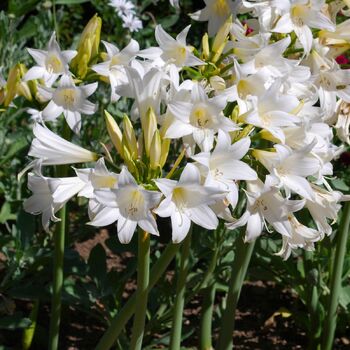
How to Grow Belladonna Lily Bulbs
Grow Guide #2913
Family: Amaryllidaceae
Binomial name: Amaryllis belladonna
Life Cycle: Perennial
This 'How to Grow' guide details everything a home gardener needs to know to plant, grow and care for Belladonna lilies (Amaryllis belladonna).
When to Plant Belladonna Lily Bulbs
Use the table below to identify the best time of year to plant belladonna lily bulbs in your climate.
| JAN | FEB | MAR | APR | MAY | JUN | JUL | AUG | SEP | OCT | NOV | DEC | |
|---|---|---|---|---|---|---|---|---|---|---|---|---|
| Cool | ||||||||||||
| Temperate | ||||||||||||
| Sub-Tropical | ||||||||||||
| Tropical | ||||||||||||
| Arid |
Preparation
Belladonna lily plants are best grown in full sun. Choose a location that will receive at least 6 hours of full sun each day.
Belladonna lily plants are perennial, meaning they live for several years. Choose a permanent position where plants can grow undisturbed by regular digging.
Belladonna lily plants need a loose, well drained soil enriched with organic matter. Prepare soil by weeding it thoroughly, digging it over to at least a spade’s depth to loosen the soil, and adding aged animal manure or compost. Organic matter can be dug into heavy soil to lighten it so roots can grow freely. Keep the area free of weeds until planting. Learn more about preparing soil for planting here.
Belladonna lily plants can be grown in containers. If possible choose a variety that’s recommended for container growing. Use a good quality potting mix and make sure your container is large enough for mature plants; a minimum of 20 litres is recommended for belladonna lilies. During the growing season, keep in mind that container grown plants may need additional fertiliser to encourage healthy growth.
How to Plant Belladonna Lily Bulbs
Belladonna lilies should be planted directly in their final position in the garden or a container.
- Plant individual bulbs 20-40cm apart.
- Plant with the tip pointing upwards, with one third of the bulb above soil level. This helps keep the top growing point of the bulb dry and free of disease.
- Cover with soil and water in well.
How to Grow Belladonna lily
Belladonna lily plants may need watering during the growing season. Water when the soil is dry about 5cm below the surface (test this by scratching away a little soil with your finger). Water deeply in the early morning or late afternoon. Avoid watering the leaves of plants to avoid fungal diseases. Learn more about watering here.
If soil was well prepared no extra fertiliser should be necessary, as bulbs store all the energy needed to bloom from the previous year's growth. In poor soil or to give your plants an extra boost, application of a high-potassium fertiliser or one formulated for flowering plants can be beneficial:
- apply slow release fertiliser at the recommended rate when the first shoots emerge, OR
- apply liquid fertiliser at the recommended rate and frequency when the first shoots emerge.
After flowering, fertilise bulbs with blood and bone or aged or pelletised chicken manure and water in well.
Belladonna lily plants should flower in approximately 120-180 days. Bulbs that have been left to naturalise for several years produce more flowers per stem than newly planted bulbs.
Deadhead or cut belladonna lily flowers regularly during the growing season. Using sharp secateurs or snips, cut flowers for picking with the longest stems possible, or snap off dead flowers. Removing old flowers regularly will direct the plant's energy back into the bulb rather than into the production of seeds.
Leave foliage to die down naturally after flowering; the bulb will absorb the nutrients in the leaves and use them to form the flowers for next season. Once all foliage has died down use sharp secateurs or snips to cut individual leaves at ground level.
In cold climates with regular frosts, bulbs should be protected with a heavy mulch in winter.
Belladonna lily bulbs can remain in the ground for several years without the need to lift and divide them. Mulch heavily to protect bulbs from very hot temperatures over summer. Bulbs can be lifted in areas that experience wet summers, if they become overcrowded or to move them to a different location in the garden.
To lift belladonna lily bulbs, use a garden fork to lift the bulbs from the soil, taking care not to damage them. Prune off any dead leaves still attached to the bulb. Store bulbs in a cool, dry space on a wire rack or in a bag that allows good airflow, such as one made from netting. Temperatures around 20 degrees are ideal for storage; exposure to hot temperatures (over 30 degrees) may affect the viability of the bulbs. Bulbs can be replanted the following season in line with the planting chart above.
Common Problems when Growing Belladonna lilies
Like all plants, belladonna lily is susceptible to some pests, diseases and other problems. Below is a list of the most common problems gardeners encounter when growing belladonna lily plants:
 Aphids are small (2-4mm long) sap-sucking insects that congregate on the new shoots or the undersides of leaves. They can cause leaves to wilt or become discoloured, and also excrete honeydew which can attract ants and other insect pests. To manage aphids, remove them by spraying with a garden hose, apply a soap or alcohol spray, or encourage predatory insects to your garden. Read more about aphids here.
Aphids are small (2-4mm long) sap-sucking insects that congregate on the new shoots or the undersides of leaves. They can cause leaves to wilt or become discoloured, and also excrete honeydew which can attract ants and other insect pests. To manage aphids, remove them by spraying with a garden hose, apply a soap or alcohol spray, or encourage predatory insects to your garden. Read more about aphids here. Mealybugs (Pseudococcidae sp.) are small (3-6mm long) sap-sucking insects with white, pink or gray bodies covered in a mealy coating that looks like cotton wool. They can cause leaves to wilt and also excrete honeydew which can attract ants and other insect pests. To manage mealybugs, remove them by wiping leaves, apply a soap or alcohol spray, or encourage predatory insects to your garden. Read more about mealybugs here.
Mealybugs (Pseudococcidae sp.) are small (3-6mm long) sap-sucking insects with white, pink or gray bodies covered in a mealy coating that looks like cotton wool. They can cause leaves to wilt and also excrete honeydew which can attract ants and other insect pests. To manage mealybugs, remove them by wiping leaves, apply a soap or alcohol spray, or encourage predatory insects to your garden. Read more about mealybugs here. Slugs and snails are molluscs that feed on tender leaves and shoots, mostly at night, leaving slimy trails behind them. Control them by removing their hiding places, keeping free range poultry, collecting them by torchlight or by placing traps. Read more about slugs and snails here.
Slugs and snails are molluscs that feed on tender leaves and shoots, mostly at night, leaving slimy trails behind them. Control them by removing their hiding places, keeping free range poultry, collecting them by torchlight or by placing traps. Read more about slugs and snails here.


.png)




